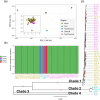Population Genomics Reveals Distinct Lineage of the Asian Soybean Rust Fungus Phakopsora pachyrhizi in the United States of America Unrelated to Brazilian Populations
- PMID: 40773485
- PMCID: PMC12330935
- DOI: 10.1111/mpp.70135
Population Genomics Reveals Distinct Lineage of the Asian Soybean Rust Fungus Phakopsora pachyrhizi in the United States of America Unrelated to Brazilian Populations
Abstract
Asian soybean rust (ASR), caused by the obligate biotrophic fungus Phakopsora pachyrhizi, was first reported in the continental United States of America (USA) in 2004 and over the years has been of concern to soybean production in the United States. The prevailing hypothesis is that P. pachyrhizi spores were introduced into the United States via hurricanes originating from South America, particularly hurricane Ivan. To investigate the genetic diversity and global population structure of P. pachyrhizi, we employed exome-capture based sequencing on 84 field isolates collected from different geographic regions worldwide. We compared the gene-encoding regions from all these field isolates and found that four major mitochondrial haplotypes are prevalent worldwide. Here, we provide genetic evidence supporting multiple incursions that have led to the currently established P. pachyrhizi population of the United States. Phylogenetic analysis of mitochondrial genes further supports this hypothesis. We observed limited genetic diversity in P. pachyrhizi populations across different geographic regions, suggesting a clonal population structure. Additionally, this study is the first to report the F129L mutation in the Cytb gene outside South America, which is associated with strobilurin tolerance. This study provides the first comprehensive characterisation of P. pachyrhizi population structures defined by genetic evidence from populations across major soybean-growing regions.
Keywords: Phakopsoraceae; Pucciniales; fungicide resistance; lineages; population structure; soybean rust.
© 2025 The Author(s). Molecular Plant Pathology published by British Society for Plant Pathology and John Wiley & Sons Ltd.
Conflict of interest statement
The authors declare no conflicts of interest.
Figures




Similar articles
-
Analysis of the genetic diversity of the soybean rust pathogen Phakopsora pachyrhizi reveals two major evolutionary lineages.Fungal Genet Biol. 2025 Jun;179:103990. doi: 10.1016/j.fgb.2025.103990. Epub 2025 May 2. Fungal Genet Biol. 2025. PMID: 40319936
-
Allelic variability in the Rpp1 locus conferring resistance to Asian soybean rust revealed by genome-wide association.BMC Plant Biol. 2024 Aug 3;24(1):743. doi: 10.1186/s12870-024-05454-1. BMC Plant Biol. 2024. PMID: 39095733 Free PMC article.
-
First Report of Soybean Rust Caused by Phakopsora pachyrhizi in the Continental United States.Plant Dis. 2005 Jul;89(7):774. doi: 10.1094/PD-89-0774A. Plant Dis. 2005. PMID: 30791253
-
Soybean anthracnose caused by Colletotrichum species: Current status and future prospects.Mol Plant Pathol. 2021 Apr;22(4):393-409. doi: 10.1111/mpp.13036. Epub 2021 Feb 20. Mol Plant Pathol. 2021. PMID: 33609073 Free PMC article. Review.
-
Soybean-Phakopsora pachyrhizi interactions: towards the development of next-generation disease-resistant plants.Plant Biotechnol J. 2024 Feb;22(2):296-315. doi: 10.1111/pbi.14206. Epub 2023 Oct 26. Plant Biotechnol J. 2024. PMID: 37883664 Free PMC article. Review.
References
-
- Abebe, A. T. , Belachew K., Hailemariam M., Sileshi Y., and Ortega‐Beltran A.. 2022. “Interaction of Varieties and Fungicides Across Seasons and Locations for the Control of Asian Soybean Rust (Phakopsora pachyrhizi) in Southwestern Ethiopia.” Crop Protection 158: 106008.
-
- Acuña, R. , Rouard M., Leiva A. M., et al. 2022. “First Report of Fusarium oxysporum f. sp. cubense Tropical Race 4 Causing Fusarium Wilt in Cavendish Bananas in Peru.” Plant Disease 106: PDIS09211951PDN.
-
- Akamatsu, H. , Yamanaka N., Soares R. M., et al. 2017. “Pathogenic Variation of South American Phakopsora pachyrhizi Populations Isolated From Soybeans From 2010 to 2015.” Japan Agricultural Research Quarterly: JARQ 51: 221–232.
-
- Akamatsu, H. , Yamanaka N., Yamaoka Y., et al. 2013. “Pathogenic Diversity of Soybean Rust in Argentina, Brazil, and Paraguay.” Journal of General Plant Pathology 79: 28–40.
MeSH terms
LinkOut - more resources
Full Text Sources

